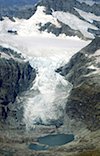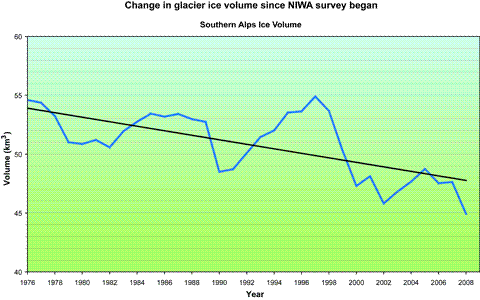 New Zealand’s glaciers lost 2.5 km3 (2.2 billion tonnes) of permanent ice from April 2007 to March 2008, leaving 44.9 km3 of ice in the Southern Alps – the lowest amount since NIWA began regular surveys 32 years ago. The picture (credit: “Mr Ice” Trevor Chinn, click for larger image) shows the Marion Glacier in the Arawata Valley in South Westland which has recently retreated above its proglacial lake. The annual survey uses a fixed wing aircraft to record the height of the snowline at the end of summer (and Trevor gets to take the pix). Jim Salinger, NIWA’s principal scientist, says that the survey shows that the glaciers had lost a lot more ice than they had gained over the preceding winter [press release]:
New Zealand’s glaciers lost 2.5 km3 (2.2 billion tonnes) of permanent ice from April 2007 to March 2008, leaving 44.9 km3 of ice in the Southern Alps – the lowest amount since NIWA began regular surveys 32 years ago. The picture (credit: “Mr Ice” Trevor Chinn, click for larger image) shows the Marion Glacier in the Arawata Valley in South Westland which has recently retreated above its proglacial lake. The annual survey uses a fixed wing aircraft to record the height of the snowline at the end of summer (and Trevor gets to take the pix). Jim Salinger, NIWA’s principal scientist, says that the survey shows that the glaciers had lost a lot more ice than they had gained over the preceding winter [press release]:
“As a result of La Niña conditions over New Zealand, more easterlies, and warmer than normal temperatures, there was less snowfall in the Southern Alps and more snowmelt. The higher the snow line, the more snow is lost to feed the glacier. On average, the snow line this year was about 130 metres above where it would need to be to keep the ice mass constant.â€
More below the fold…

The graph shows the change in glacier ice volume since the NIWA survey began in 1976. The 2008 loss was the fourth largest in the record.
From NIWA’s background notes:
Worldwide, glaciers are regarded as a useful indicator of global warming, but New Zealand’s glaciers are more complicated because they have their source in areas of extremely high precipitation. West of the Main Divide in the Southern Alps, more than 10 metres (10 000 mm) of precipitation falls each year as clouds are pushed up over the sharply rising mountain ranges. This means the mass and volume of New Zealand’s glaciers is sensitive to changing wind and precipitation patterns as well as to temperature. So, for example, the glaciers advanced during most of the 1980s and 1990s when the area experienced about a 15% increase in precipitation, associated with more El Niño events and stronger westerly winds over New Zealand. The glaciers in parts of Norway are similar.
Despite the sensitivity of New Zealand glaciers to changes in both precipitation and temperature, the volume of ice in the Southern Alps dropped by roughly 50% during the last century. New Zealand’s temperature increased by about 1 °C over the same period.
And even though Mt Hutt has had a record snow season, NIWA note:
The level of the glacier snow lines is not necessarily closely related to the amount of snow that falls on the country’s ski fields during winter. Most of the popular ski fields are east of the Main Divide, or in the North Island. Mount Hutt, for instance, gets its snow from big southeasterlies, whereas most of the glaciers are fed by westerlies.
[Update 15/9: Jim Salinger was on press duty yesterday, handing out quotes to the local media, and in so doing invented a new unit of measurement – the Rangitoto – to be used when explaining large volumes to Aucklanders.]
[Update 2: Jim’s been kind enough to send me a copy of a recent article from NIWA’s magazine: Glacier response to climate change, Salinger, Chinn, Willsman & Fitzharris, W&A 16 (3) 2008 (2.8MB PDF) which goes into more detail about NZ glaciers in a warming world.]

Link to the report?
Just a press release at the moment, Steve. The meat of it is in the post. There may be something more detailed later – I’ll check.
Graph shows approx. 12% decline in volume over 32 years. If total loss over last century is approx. 50%, does this meant decline is slowing? (If there is a linear relationship with time, I would have expected decline over century to be only 40%) – just wondering
The NIWA release points out that the mass balance depends on precipitation up at the main divide, and that’s heavily influenced by ENSO. El Ninos bring cooler weather and more snow, La Ninas the reverse, so the frequency and strength of those events will dominate the process (PDO/IPO link, perhaps) – and be overlaid on the underlying warming trend. Also worth noting that NIWA’s RCM suggests that warming will be particularly intense in the Alps, so that trend may steepen as the decades go by.
Thanks Gareth – clarified that for me -cheers
Much the same story in the French Alps, where I’ve just been. I’m looking forward to comparing my photos on the Vanoise glaciers with those of a friend who lived there in the 1970s.
This site is looking GREAT, Gareth, and is as interesting and well-informed as ever.
Glaciers have been receding globally for 250 years. There is no evidence that this is increasing.
Extracting a Climate Signal from 169 Glacier Records
J. Oerlemans, et al. Science 308, 675 (2005); DOI: 10.1126/science.1107046
the world glacier monitoring service would disagree [GLACIER MASS BALANCE BULLETIN Bulletin No. 9 (2004–2005)]:
“The melt rate and loss in glacier thickness continues to be extraordinary. This development further confirms the accelerating trend in worldwide glacier disappearance, which has become more and more obvious during the past two decades.”
Thanks rata.
From the WGMS preliminary figures for 2006:
[Emphasis mine]
So, Steve, got any other vapid assertions?
And thanks, Carol, for the kind comments. 😉
Gareth, WE (regular readers) should be thanking YOU for providing this wondrous resource.
Beautiful. Many things are growing: GHG emissions, population size, water shortages, deforestation, loss of biodiversity, depletion of fossil fuels, frequencies of droughts and floods, the loss of glacier volume and more.
Constants are the size of the planet and the blatant incompetence of our leaders of all political colours to understand that resources are finite and growth is the sure road to total depletion, wars for the last resources, collapse and the demise of mankind. Cheers … Helmutatecoglobedotorgdotnz
Ecoglobe – 2008 tempertures are falling though. Resources are finite, even the sun, but new technologies will help us adapt over the next say 50 years.
Meanwhile approximately 5 degrees further north Turoa has had record snowfall and there will be sking until Jan 2009!!!!!
http://www.nzherald.co.nz/nz/news/article.cfm?c_id=1&objectid=10533086